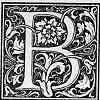 HOME
HOMEEncyclopedia Home Page
B
BAAL - BARN
BARR - BELC
BELE - BLUE
BIBLE
BOAR - BREA
BRET - BUIL
BUL - BY


The President and six of the twenty-four members are annually nominated by the Grand Master, and the remaining eighteen are elected by the Grand Lodge from the Masters and Past Masters of the Lodges. This board has authority to hear and determine all subjects of Masonic complaints, or irregularity respecting Lodges or individual Freemasons, when regularly brought before it, and generally to take cognizance of all matters relating to the Craft.
See Relief, Board of
The name of the left hand (or north) pillar that stood at the porch of King Solomon's Temple. It is derived from the Hebrew pronounced bo'-az, and signifies in strength. Though Strong in his Hebrew and Chaldee Dictionary says the root is unused and of uncertain meaning (see Pillars of the Porch).
A Hebrew word pronounced bokeem and meaning the weepers. A password in the Order of Ishmael. An angel spoke to Hagar as she wept at the well when in the wilderness with her son Ishmael.
The angel is looked upon as a spiritual being, possibly the Great Angel of the Covenant, the Michael who appeared to Moses in the burning bush, or the Joshua, the captain of the hosts of Jehovah.
Born in Brunswick, 16th of January, 1730. One of the most distinguished Freemasons of his time. In his youth he was a professional musician, but in 1757 he established himself at Hamburg as a bookseller, and was initiated into the Masonic Order. He obtained much reputation by the translation of Sterne's Sentimental Journey and Tristram Shandy, of Goldsmith's Vicar of Wakefield; Smollett's Humphrey Clinker; and of Fielding's Tom Jones, from the English; and of Montaigne's works from the French. To Masonic literature he made many valuable contributions; among others, he translated from the French Bonneville's celebrated work entitled Les Jésuites chassés de la Maçonnerie et leur poignard bris par les Maçons, meaning The Jesuits driven from Freemasonry and their weapon broken by the Freemasons, which contains a comparison of Scottish Freemasonry with the Templarism of the fourteenth century, and with sundry peculiar practices of the Jesuits themselves.
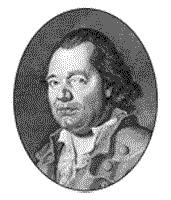 |
Bode was at one time a zealous promoter of the Rite of Strict Observance, but afterward became one of its most active opponents. In 1790 he joined the Order of the Illuminati, obtaining the highest Degree in its second class, and at the Congress of Wilhelmsbad he advocated the opinions of Weishaupt. No man of his day was better versed than he in the history of Freemasonry, or possessed a more valuable and extensive library; no one was more diligent in increasing his stock of Masonic knowledge, or more anxious to avail himself of the rarest sources of learning. Hence, he has always held an exalted position among the Masonic scholars of Germany. The theory which he had conceived on the origin of Freemasonry - a theory, however, which the investigations of subsequent historians have proved to be untenable - was, that the Order was invented by the Jesuits, in the seventeenth century, as an instrument for the re-establishment of the Roman Church in England, covering it for their own purposes under the mantle of Templarism. Bode died at Weimar on the 13th of December, 1793. |
A Royal Councilor of State and Director of the School of Cadets at St. Petersburg, during the reign of Alexander I. In 1805 he induced the emperor to revoke the edicts made by Paul I and himself against the Freemasons. His representations of the true character of the Institution induced the emperor to seek and obtain initiation.
Boeber may be considered as the reviver of Freemasonry in the Russian dominions, and was Grand Master of the Grand Lodge from 1811 to 1814.
The most celebrated of the Mystics of the sixteenth and seventeenth centuries, born near Gorlitz, in 1575, and died in 1624. His system attracted, and continued to attract long after his death, many disciples in Germany. Among these, in time, were several Freemasons, who sought to incorporate the mystical dogmas of their founder with the teachings of Freemasonry, so as to make the Lodges merely schools of theosophy. Indeed, the Theosophic Rites of Freemasonry, which prevailed to a great extent about the middle of the last century in Germany and France, were indebted for most of their ideas to the mysticism of Jacob Boehmen.
Born in 1770, at Jönköping in the south of Sweden. He was a very zealous member of the Order of Asiatic Brethren, and was an active promulgator of the advanced Degrees. Invited to Sweden, in 1802, by the Duke of Sudermania, who was an ardent inquirer into Masonic science, he was appointed Court Secretary.
He attempted to introduce his system of advanced Degrees into the kingdom, but having been detected in the effort to intermingle revolutionary schemes with his high Degrees, he was first imprisoned and then banished from the country, his society being interdicted. He returned to Germany, but is not heard of after 1815, when he published at Plymouth a justification of himself. Findel in his History of Freemasonry (page 560), calls him an impostor, but he seems rather to have been a Masonic fanatic, who was ignorant of or had forgotten the wide difference between Freemasonry and political intrigue.
A Lodge named The Three Stars is said to have been established at Prague in 1726, and other Lodges were subsequently constituted in Bohemia, but in consequence of the French Revolution they were closed in 1793 by the Austrian Government.
A merchant in Stockholm, 1695-1767, who left a legacy of 100,000 thalers to the Asylum for the Orphans of Freemasons that was founded in Stockholm in 1753. A medal was struck in his honor in 1768 (see Marvin's Masonic Medals, page 172).
The third largest political division of the continent of South America. A Lodge was chartered in Bolivia in 1875. Three others have since been established and all four pay allegiance to the Grand Lodge of Peru.
Brother Oliver Day Street says in his 1922 Report on Correspondence to the Grand Lodge of Alabama:
"So far as we have been able to ascertain this State has never been able to boast a Grand Lodge, Grand Orient or Supreme Council of its own. Its only Masonic organizations have been Lodges chartered by some of the Grand Lodges of the neighboring states. Indeed, Peru and Chile are the only ones we can ascertain which have even done this. Bolivia can scarcely be said to have a Masonic history".
|
A seaport on the west coast of India. The first Lodge to be established in Bombay was opened in 1758 but it disappeared from the register in 1813. In 1763 James Todd was appointed Provincial Grand Master. A Provincial Grand Master of Western India and its Dependencies, Brother James Burnes was appointed in 1836 by the Grand Lodge of Scotland. None had been appointed by England since the time of Brother Todd. Brother Burnes was a very active Freemason and it is a curious fact that Brethren even left the English Lodges to support the new Scotch Bodies. English Freemasonry became less and less popular and finally ceased to be practiced until 1848 when Saint George Lodge No. 807, was revived. |
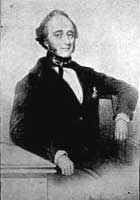 James Burnes |
In 1886 Scotland had issued nineteen Charters to Lodges in Bombay and twelve years previously Captain Morland, successor to Brother Burnes, was raised to the position of Grand Master of all Scottish Freemasonry in India.
The Craft took no firm hold on the natives of India.
Several of the princes were initiated but the Parsees made the first real advance in the Order when Brother Cama, one of their number, was elected Treasurer of the Grand Lodge of England. The first Hindu to hold important office was Brother Dutt who became head of a Lodge in 1874 (see India and Madras).
Brother Hawkins was of the opinion that the word is really an incorrect transliteration of the Hebrew word for builders, which should be Bonim; the construct form of which Bonai is used in 1 Kings (v 18), to designate a portion of the workmen on the Temple:
"And Solomon's builders and Hiram's builders did hew them".
Brother Hawkins continues to the effect that Oliver, in his Dictionary and in his Landmarks (1, 402), gives a mythical account of them as Fellow Crafts, divided into Lodges by King Solomon, but, by a slip in his grammar he calls them Benai, substituting the Hebrew construct for the absolute case, and changing the participial o into e. The Bonaim seem to be distinguished, by the author of the Book of Kings, from the Gibalim, and the translators of the authorized version have called the former builders and the latter stone-squarers. It is probable that the Bonaim were an order of workmen inferior to the Gibalim. Anderson, in both of his editions of the Book of Constitutions, errs like Oliver, and calls them Bonai, saying that they were "setters, layers, or builders, or light Fellow Crafts, in number 80,000".
This idea seems to have been perpetuated in the modern rituals. From this construct plural form Bonai some one has formed the slightly incorrect form Bonaim.
BONAPARTE, JEROMEBrother of Napoleon I. Born November 15, 1784, and died June 24, 1860. King of Westphalia from 1807 to 1813 and afterwards known as the Duc de Montfort. Grand Master of the Grand Orient of Westphalia. After 1847 he became successively Governor of the Invalides, Marshal of France and President of the Senate (see also Histoire de la Franc-Maçonnerie, Albert Lantoine, 1925, Paris). Jerome, son of the above, also given as a Freemason. |
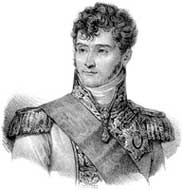 |
BONAPARTE, JOSEPHElder brother of Napoleon I. Born January 7, 1768. Sent to Naples as King in 1806 and made King of Spain in 1808. After 1815 known as Comte de Survilliers. He was a Freemason. Appointed by Napoleon I to the office of Grand Master of the Grand Orient of France in 1804. He died July 28, 1844. |
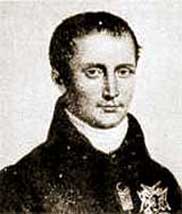 |
BONAPARTE, LOUISBorn September 2, 1778; died July 25, 1846. Brother of Napoleon I. King of Holland in 1806. Grand Master Adjoined of the Grand Orient of France in 1804. In 1805 became Governor of Paris. |
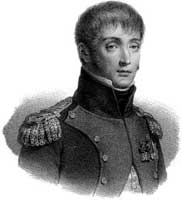 |
BONAPARTE, LUCIENBrother of Napoleon I. Born May 21, 1775, and died at Rome, June 29, 1840. November 10, 1799, when Napoleon I overthrew the National Councils of France at the Palace of Saint Cloud, Lucien was President of the Council of Five Hundred and able to turn the scale in favor of his brother. In 1800 was Ambassador at Madrid, Spain. A member of the Grand Orient of France. |
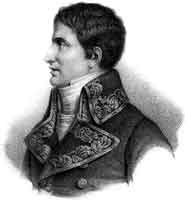 |
In the fourth article of the Halliwell or Regius Manuscript, which is the earliest Masonic document known, it is said that the Master shall take good care that he make no bondman an apprentice, or, as it is in the original language:
The fourth artycul thys moste be,
That the Mayster hymn wel be-se,
That he no bondemon prentys make.
The regulation is repeated in all the subsequent regulations, and is still in force (see Freebom).
This word, which is now pronounced in one syllable, is the Hebrew word bo-neh, builder, from the verb banah, to build. It was peculiarly applied, as an epithet, to Hiram Abif, who superintended the construction of the Temple as its chief builder. Master Masons will recognize it as part of a significant word. Its true pronunciation would be, in English letters, bo-nay; but the corruption into one syllable as bone has become too universal ever to be corrected.
In the early lectures of the eighteenth century, now obsolete, we find the following catechism:
The bone box is the mouth, the ivory keys the teeth. And the key to the secrets is afterward said to be the tongue.
These questions were simply used as tests, and were subsequently varied. In a later lecture it is called the Bone-bone Box.
On the 24th of November, 1754, he founded the Chapter of the Advanced Degrees known as the Chapter of Clermont. All the authorities assert this except Rebold, Histoire des Trois Grandes Loges, meaning the History of the Three Grand Lodges, page 46, who says that he was not its founder but only the propagator of its Degrees.
A bookseller and man of letters, born at Evreux, in France, March 13, 1760. He was the author of a work, published in 1788, entitled Les Jésuites chassés de la Maçonnerie et leur poignard brisé par les Maçons, meaning The Jesuits driven from Freemasonry and their weapon broken by the Freemasons, a book divided into two parts, of the first of which the subtitle was La Maçonnerie écossaise comparée avec les trois professions et le Secret des Templiers du 14e Siécle, meaning Scottish Freemasonry compared with the three professions and the Secret of the Templars of the Fourteenth Century, and of the second, Mémeté des quatre voeux de la Compagnie de S. Ignace, et des quatre grades de la Maçonnerie de S. Jean, meaning the Identity of the four pledges of the Society of Saint Ignace, and of the four steps of the Freemasonry of Saint John. He also translated into French, Thomas Paine's Essay on the Origin of Freemasonry; a work, by the way, which was hardly worth the trouble of translation.
De Bonneville had an exalted idea of the difficulties attendant upon writing a history of Freemasonry, for he says that, to compose such a work, supported by dates and authentic facts, it would require a period equal to ten times the age of man; a statement which, although exaggerated, undoubtedly contains an element of truth.
His Masonic theory was that the Jesuits had introduced into the symbolic Degrees the history of the life and death of the Templars, and the doctrine of vengeance for the political and religious crime of their destruction; and that they had imposed upon four of the higher Degrees the four vows of their congregation. De Bonneville was imprisoned as a Girondist in 1793. The Girondists or Girondins were members of a political party during the French Revolution of 1791 to 1793, getting their name from twelve Deputies from the Gironde, a Department of Southwestern France. He was the author of a History of Modern Europe, in three volumes, published in 1792. He died in 1828.
See Anti-Masonic Books
There seems, if we may judge from the references in the old records of Freemasonry, to have formerly existed a book under this title, containing the Charges of the Craft; equivalent, probably, to the Book of Constitutions. Thus, the Matthew Cooke Manuscript of the first half of the fifteenth century (line 534) speaks of "othere chargys mo that ben wryten in the Boke of Chargys".
|
In England of the Eighteenth Century a permanent association or society was required to have a sponsor, the more exalted in the rank the better, who was named as its Patron - as the King himself was Patron of the Royal (scientific) Society; it was also expected to have authorization in the form of a charter, or deputation, or some similar instrument; and the older one of these written instruments might be, other things being equal, the more weight it possessed. The old Masonic Lodges in London at the beginning of the Century had Sir Christopher Wren as their patron (so tradition affirms) and for written charter each one had a copy of the Old Charges; these documents attested that their original authority had been a Royal Charter granted by a Prince Edwin seven centuries before; and though historians, for sound reasons, question this particular claim, it is important to remember that neither the Lodges nor the public between 1700 and 1725 ever questioned it. |
|
In 1716 representatives of some four or five old Lodges, and Probably after discussions with other Lodges not represented, decided to set up a Body in which each Lodge could be a member, and which would be a central meeting place and at the same time could bring the Lodges into a unity of work and practice. This they called a Grand ( or chief) Lodge; and in 1717 they erected it by official action, and put Anthony Sayer in the Chair as Grand Master.
This new Grand Lodge was itself a Lodge and therefore needed both a Patron and a Charter, or Old Charges, of its own, and suitable for needs not identical with those of a member Lodge. It found a Patron in the person of the Duke of Montague, elected Grand Master in 1721, after a time, and especially after the sons of George I had become Masons, it was under the patronage of the Royal Family and has been so ever since (Queen Victoria officially declared herself its Patroness).
|
To prepare a Grand Lodge equivalent of the Old Charges was a more difficult matter. Veteran Masons were consulted; old manuscripts were borrowed from Lodges (and sometimes not returned, as when Desaguliers forgot to return documents to the Lodge of Antiquity). Some of the Lodges which were opposed to the whole Grand Lodge plan destroyed their documents. An unknown group of Masons forestalled the Grand Lodge by having J. Roberts print a version, now called the Roberts Constitutions, dated 1722 (of the two existing copies one is in the Iowa Masonic Library). From the Lodges in favor of the Grand Lodge plan fourteen veteran Masons acted as an advisory committee. By 1722 George Payne, a Grand Master, had prepared an acceptable version of that part of the Old Charges, the important half, which was called the Old Regulations. By the following year, Grand Lodge, reporting through a Committee headed by James Anderson, adopted a completed manuscript, entitled it The Constitution of Freemasons, and had James Anderson print it. Why this book has been accredited to the authorship of James Anderson is a mystery; he is called "author" at one or two places but as then used the word could mean "editor" or "scribe"; and his name does not appear on the title page. Payne wrote about one-half of it. J. T. Desaguliers wrote the dedication; the rest of it was the joint work of many hands and at least two Committees. The so-called historical part was collected-the record says "collated" from Lodge copies of the Old Charges which differed much among themselves in detail. The title is a complete description of the book: |
|
"The Constitution, History, Laws, Charges, Orders, Regulations, and Usages of the Right Worshipful FRATERNITY of Accepted Free MASONS; collected From their general RECORDS and their faithful TRADITIONS of many Ages.
To be Read At the Admission of a NEW BROTHER, when the Master or Warden shall begin, or order some other Brother to read as follows".
Then follows the text, in the first sentence of which reference is made to "God, the great Architect of the Universe", and Geometry is named as the Masonic art par excellence, because it was the art used in architecture.
The publisher's signature on the title page:
"London, Printed by William Hunter, for John Senex at the Globe, and John Hooke at the Flower-de-luce over against St. Dunstan's Church, in Fleet-Street. In the Year of Masonry 5723. Anno Domini 1723".
This dating is a fact of prime importance, for it proves that the Freemasons identified their Fraternity with architecture which they rightly assumed to be as old as man. Theorists who have argued for another origin of Freemasonry, among the Ancient Mysteries, or in occult circles, or in political circles, etc., will first have to explain why the founders of the Speculative Craft had not even heard of such origins; and one may safely assume that they knew more about the founding of Speculative Masonry than theorism two hundred years afterwards. As time passed, and Lodges increased, amendments and revisions were called for; this was satisfied by the issuance of new editions.
NOTE. The Fifth, or 1784, Edition is there accredited to John Northouck, in reality it should have been named after William Preston because he did the work on it. As each new Grand Lodge was erected in one Country after another, and in America in one State after another, it wrote or adopted a Book of its own. Such a Book dated as of today bears on the face of it little resemblance to the Edition of 1723; but the change from decade to decade has been a gradual one, always made in response to new needs, and in their principles and every other fundamental any regular Constitution of today is a direct descendant of the Constitution of 1723. The Ancient Grand Lodge, erected in London in 1751, which was to become a rival of the 1717 Grand Body until 1813, published in 1756 a Book of its own, which it called Ahiman Rezon; this also was in substance a repetition of the Book of 1723. Considered as a work of literature the most masterly version is the original Constitution of Ireland, a re-writing of the 1723 Edition by John Pennell, published in 1730.
first, that the Grand Lodge began in 1716-not 1717- and that those gentlemen were not Masons for some time afterwards, at least not London Masons, and were not among the founding fathers,
second, the old Lodges were not "Operative" but only partly so, and one of them was wholly composed of Speculatives. Desaguliers and his colleagues were architects of the Grand Lodge system; they did not create anything new, they only found a new way for carrying on what was already very old. This is made clear by the Book of 1723 itself, and by the circumstances under which it was prepared.
The Book of Constitutions is that work in which is contained the rules and regulations adopted for the government of the Fraternity of Freemasons. Undoubtedly, a society so orderly and systematic must always have been governed by a prescribed code of laws; but, in the lapse of ages, the precise regulations which were adopted for the direction of the Craft in ancient times have been lost. The earliest record that we have of any such Constitutions is in a manuscript, first quoted, in 1723, by Anderson (Constitutions, 1723, pages 32-3), which he said was written in the reign of Edward IV.
Preston (page 182, edition of 1788) quotes the same record, and adds, that "it is said to have been in the possession of the famous Elias Ashmole, and unfortunately destroyed", a statement which had not been previously made by Anderson. To Anderson, therefore, we must look in our estimation of the authenticity of this document; and that we cannot too much rely upon his accuracy as a transcriber is apparent, not only from the internal evidence of style, but also from the fact that he made important alterations in his copy of it in his edition of 1738. Such as it is, however, it contains the following particulars:
"Though the ancient records of the Brotherhood in England were many of them destroyed or lost in the wars of the Saxons and Danes, yet King Athelstan (the grandson of King Alfrede the Great, a mighty Architect), the first anointed king of England, and who translated the Holy Bible into the Saxon tongue, 930 A. D., when he had brought the land into Rest and Peace, built many great works, and encouraged many Masons from France, who were appointed Overseers thereof, and brought with them the Charges and Regulations of the Lodges preserved since the Roman times, who also prevailed with the King to improve the Constitution of the English Lodges according to the foreign Model, and to increase the Wages of Working Masons.
|
|
Other records have from time to time been discovered, most of them recently, which prove beyond a1l doubt that the Fraternity of Freemasons was, at least in the fourteenth, fifteenth, sixteenth, and seventeenth centuries, in possession of manuscript Constitutions containing the rules and regulations of the Craft.
In the year 1717, Freemasonry, which had somewhat fallen into decay in the south of England, was revived by the organization of the Grand Lodge at London; and, in the next year, the Grand Master having desired, says Anderson:
"any brethren to bring to the Grand Lodge any old writings and records concerning Freemasons and Freemasonry, in order to show the usages of ancient times, several old copies of the Gothic Constitutions were produced and collated" (see Constitutions, 1738, page 110).
But these Constitutions having been found to be very erroneous and defective, probably from carelessness or ignorance in their frequent transcription, in September, 1721, the Duke of Montagu, who was then Grand Master, ordered Brother James Anderson to digest them "in a new and better method" (see Constitutions, 1738, page 113).
Anderson having accordingly accomplished the important task that had been assigned him, in December of the same year a committee, consisting of fourteen learned Brethren, was appointed to examine the book; and, in the March Communication of the subsequent year, having reported their approbation of it, it was, after some amendments, adopted by the Grand Lodge, and published, in 1723, under the title of The Constitutions of the Freemasons, containing the History, Charges, Regulations, etc., of that Most Ancient and Right Worshipful Fraternity. For the use of the Lodges. A second edition was published in 1738, under the superintendence of a committee of Grand Officers (see the Constitutions of that year, page 133). But this edition contained so many alterations, interpolations, and omissions of the Charges and Regulations as they appeared in the first, as to show the most reprehensible inaccuracy in its composition, and to render it utterly worthless except as a literary curiosity. It does not seem to have been very popular, for the printers, to complete their sales, were compelled to commit a fraud, and to present what they pretended to be a new edition in 1746, but which was really only the edition of 1738, with a new title page neatly pasted in, the old one being canceled.
In 1754, Brother Jonathan Scott presented a memorial to the Grand Lodge, "showing the necessity of a new edition of the Book of Constitutions". It was then ordered that the book "should be revised, and necessary alterations and additions made consistent with the laws and rules of Masonry"; all of which would seem to show the dissatisfaction of the Fraternity with the errors of the second edition. Accordingly, a third edition was published in 1756, under the editorship of the Rev. John Entick. The fourth edition, prepared by a Committee, was published in 1767.
In 1769, G. Kearsly, of London, published an unauthorized edition of the 1767 issue, with an appendix to 1769; this was also published by Thomas Wilkinson in Dublin in the same year, with several curious plates; both issues are now very scarce. And an authorized supplement appeared in 1776.
John Noorthouck published by authority the fifth edition in 1784. This was well printed in quarto, with numerous notes, and is considered the most valuable edition; it is the last to contain the historical introduction.
After the Union of the two rival Grand Lodges of England (see Ancient Masons) in 1813, the sixth edition was issued in 1815, edited by Brother William Williams, Provincial Grand Master for Dorsetshire; the seventh appeared in 1819, being the last in quarto; and the eighth in 1827; these were called the Second Part, and contained only the Ancient Charges and the General Regulations. The ninth edition of 1841 contained no reference to the First or Historical Part, and may be regarded as the first of the present issue in octavo with the plates of jewels at the end.
Numerous editions have since been issued. In the early days of the Grand Lodge of England in all processions the Book of Constitution was carried on a cushion by the Master of the Senior Lodge (Constitution, 1738, pages 117-26), but this was altered at the time of the union and it is provided in the Constitutions of 1815 and in the subsequent issues that the Book of Constitutions on a cushion shall be carried by the Grand Secretary.
An emblem painted on the Master's carpet, and intended to admonish the Freemason that he should be guarded in all his words and actions, preserving unsullied the Masonic virtues of silence and circumspection. Such is Webb's definition of the emblem in the Freemasons monitor (edition of 1818, page 69), which is a very modern one, and Brother Mackey was inclined to think it was introduced by that lecturer. The interpretation of Webb is a very unsatisfactory one in the opinion of Brother Mackey. He held that the Book of Constitutions is rather the symbol of constituted law than of silence and circumspection, and when guarded by the Tiler's sword it would seem properly to symbolize regard for and obedience to law, a prominent Masonic duty.
In the Ancient and Accepted Scottish Rite, the volume in which the transactions, statutes, decrees, balusters, and protocols of the Supreme Council or a Grand Consistory are contained is called the Book of Gold.
This sacred book of the Mormons was first published in 1830 by Joseph Smith, who claimed to have translated it from gold plates which he had found under Divine guidance secreted in a stone box. The seat of their organization is at Salt Lake City, Utah. In this connection, Mormonism and Masonry, by Brother S. H. Goodwin, Grand Secretary of Utah, is a detailed and excellent work of reference.
By some translated the Book of the Master, containing the ancient Egyptian philosophy as to death and the resurrection. A portion of these sacred writings was invariably buried with the dead. The book in facsimile has been published by Doctor Lepsius, and translated by Doctor Birch. The story of the judgment of Amenti forms a part of the Book of the Dead, and shadows forth the verities and judgments of the unseen world.
The Amenti was the Place of Judgment of the Dead, situated in the West, where Osiris was presumed to be buried. There were forty-two assessors of the amount of sin committed, who sat in judgment, and before whom the adjudged passed in succession.
There seems to be a tie which binds Freemasonry to the noblest of the cults and mysteries of antiquity.
The most striking exponent of the doctrines and language of the Egyptian Mysteries of Osiris is this Book of the Dead, or Ritual of the Underworld, or Egyptian Bible of 165 chapters, the Egyptian title of which was The Manifestation to Light, or the Book Revealing Light to the Soul. Great dependence was had, as to the immediate attainment of celestial happiness, upon the human knowledge of this wonderful Book, especially of the principal chapters.
On a sarcophagus or tomb of the eleventh dynasty, according to the chronology of Professor Lepsius, say 2420 B.C., is this inscription:
"He who knows this book is one who, in the day of the resurrection of the underworld, arises and enters in; but he does not know this chapter, he does not enter in so soon as he arises".
The conclusion of the first chapter says:
"If a man knows this book thoroughly, and has it inscribed upon his sarcophagus, he will be manifested in the day in all the forms that he may desire, and entering into his abode will not be turned back" (see Tiele's History of Religions, page 25).
The Egyptian belief was that portions of the Book of the Dead were written by the finger of Thoth, that being the name of the Egyptian god of letters, invention and wisdom, the mouthpiece and recorder of the gods, and umpire of their disputes, back in the mist of time, 3000 B.C. The one hundred and twenty-fifth chapter describes the last judgment. The oldest preserved papyrus is of the eighteenth dynasty. Professor Lepsius fixes the date at 1591 BC.
The most perfect copy of this Book of the Dead is in the Turin Museum, where it covers one side of the walls, in four pieces, 300 feet in length.
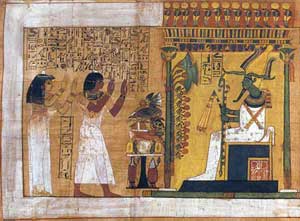 |
Papyrus page from the Book of the Dead 18th dynasty in the Egyptian Museum Turin, Italy |
The following extract is from the first chapter:
"Says That to Osiris, King of Eternity, I am the great God in the divine boat; I fight for thee; I am one of the divine chiefs who are the TRUE LIVING WORD of Osiris. I am That, who makes to be real the word of Horus against his enemies. The word of Osiris against his enemies made truth in That, and the order is executed by That. I am with Horus on the day of celebrating the festival of Osiris, the good Being, whose Word is truth; I make offerings to Ra (the Sun); I am a simple priest in the underworld, anointing in Abydos, elevating to higher degrees of initiation; I am prophet in Abydos on the day of opening or up heaving the earth. I behold the mysteries of the door of the underworld; I direct the ceremonies of Mendes; I am the assistant in the exercise of their functions; I AM GRAND MASTER OF THE CRAFTSMEN WHO SET UP THE SACRED ARCH FOR A SUPPORT" (see Truth).
Years ago, a manuscript was discovered in the archives of the City of Cologne bearing the title of Brüderschaftsbuch der Steinmetzen, meaning the Brotherhood Book of the Stonecutters, with records going back to the year 1396. Steinbrenner (Origin and Early History of Masonry, page 104), says:
"It fully confirms the conclusions to be derived from the German Constitutions, and those of the English and Scotch Masons, and conclusively proves the in authenticity of the celebrated Charter of Cologne".
The Holy Bible, which is always open in a Lodge as a symbol that its fight should be discussed among the Brethren. The passages at which it is opened differ in the various Degrees (see Scriptures, Reading of the).
Masonically, the Book of the Law is that sacred book which is believed by the Freemason of any particular religion to contain the revealed will of God; although, technically, among the Jews, the Torah, or Book of the Law, means only the Pentateuch or five books of Moses. Thus, to the Christian Freemason the Book of the Law is the Old and New Testaments; to the Jew, the Old Testament; to the Mussulman, the Koran; to the Brahman, the Vedas; and to the Parsee, the Zendavesta.
The Book of the Law is an important symbol in the Royal Arch Degree, concerning which there was a tradition among the Jews that the Book of the Law was lost during the captivity, and that it was among the treasures discovered during the building of the second Temple. The same opinion was entertained by the early Christian fathers, such, for instance, as Irenaeus, Tertullian, and Clemens Alexandrinus; "for", says Prideaux, "they (the Christian fathers) hold that all the Scriptures were lost and destroyed in the Babylonish captivity, and that Ezra restored them all again by Divine revelation". The truth of the tradition is very generally denied by Biblical scholars, who attribute its origin to the fact that Ezra collected together the copies of the law, expurgated them of the errors which had crept into them during the captivity, and arranged a new and correct edition. But the truth or falsity of the legend does not affect the Masonic symbolism. The Book of the Law is the will of God, which, lost to us in our darkness, must be recovered as precedent to our learning what is Truth. As captives to error, truth is lost to us; when freedom is restored, the first reward will be its discovery.
See Stukely, Doctor
Shute, who wrote and published the first book on architecture ever to be printed in England, is said to have been also the first engraver in England. After the Grand Lodge was formed in 1717 a long line of famous engravers were active members of the Craft; John Pine, William Hogarth, Francesco Bartolozzi, John Baptist Cipriani, Benjamin and John Cole, and our American Grand Master, inventor of a new process of engraving, Paul Revere. Their work, and especially their Masonic designs, should be studied by Masonic bookplate engravers. A Grand Lodge usually employs its own coat-of-arms in its bookplate. Pine was the first to make an engraved list of Lodges. (See also Book Plates and Their Value, J. H. Slater, Henry Grant; 1898. In addition to collectors' prices it contains a history of the development of Ex Libris art. Some publishers spell "bookplate" as one word, others as two. The Tatsch and Prescott volume contains a full bibliography. Ex Libris Lodge, No. 3765, was founded in London, 1915, by bookplate enthusiasts.)
BOONE, DANIELRay V. Denslow, specialist in early Middle Western Masonry, reported to The Builder, January, 1925, that "in his opinion" Boone had not been a Mason. He added however that "a very good friend" had in earlier days heard Boone spoken of as a Mason. Both the Grand Lodges of Kentucky and of Tennessee have searched the old membership rolls but have not found his name. When appropriating a sum toward the Boone monument at Frankfort the resolution passed by the Grand Lodge of Kentucky made no mention of Boone's possible membership. At least one pall-bearer at Boone's funeral wore a Masonic collar. (It is interesting to note that "Boone" is a corruption of "Bohun," a family name of King Henry VII.) |
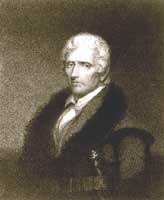 |
See Tesselated Border
An island in the Malay Archipelago, a great group of islands southeast of Asia. On August 13, 1885, Elopura Lodge, No. 2106, was chartered by the Grand Lodge of England in North Borneo at Elopura. It was, however, never constituted as the petitioners had left before the Lodge could be opened, and it was erased from the register on January 2, 1888.
Borneo Lodge of Harmony was chartered on May 6, 1891, and constituted at Sandakan on June 7, the same year.
The name is sometimes given as Bossonius. The Fourth Degree of the African Architects, also called the Christian Philosopher. The latter reference is by Thory (Acta Latomorum, 1, 297).
England in 1773 passed a law levying a tax on all tea shipped into the American Colonies by the East India Tea Company.
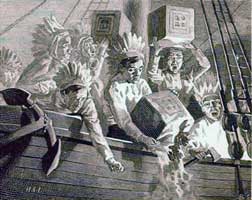 |
Three cargoes of tea were in Boston harbor when from a meeting of citizens, December 16, 1773, held at the Old South Church, forty or fifty men disguised as Indians emerged and in two or three hours three hundred and forty-two chests of tea valued at about eighteen hundred pounds sterling were emptied into the sea (see Brother Elroy McKendree Avery's History of the United States and Its People, volume v, page 166). The secrecy and dispatch of the whole affair definitely indicates previous rehearsals under competent leadership. On that very night the records written by the Secretary state that Lodge of Saint Andrew closed until the next night "On account of the few members in attendance" and then the entire page is filled up with the letters T made large (see Centennial Memorial of Saint Andrew's Lodge, page 347, also Green Dragon Tavern). |
A Scottish Laird, of Auchinleck, and of the family of the biographer of Doctor Johnson. Laird means the proprietor of a landed estate; occasionally, merely a landlord. His appearance in the Lodge of Edinburgh at a meeting held at Holyrood in June, 1600, affords a very early authentic instance of a person being a member of the Masonic Fraternity who was not an architect or builder by profession. Brother Boswell signed his name and made his mark-as did the Operatives.
BOURBON, PRINCE LOUIS DE, COMTE DE CLERMONTSaid to have been elected December 2, 1743, the fourth Grand Master in France. At first he was energetic and in 1756 the name of the Grand Lodge was changed from that of the English Grand Lodge of France to the Grand Lodge of France. He died in 1771, leaving Freemasonry in a much less flourishing condition as he neglected it during the latter part of his life, delegating his work to others (see Histoire de la Franc-Maçonnerie Française, Albert Lantoine, 1925, Paris, pages 64-9, etc.). |
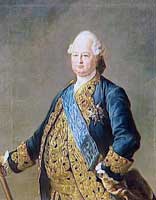 |
A limit or boundary; a word familiar to the Freemason in the Monitorial Instructions of the Fellow Craft's Degree, where he is directed to remember that we are traveling upon the level of time to that undiscovered country from whose bourn no traveler returns; and to the reader of Shakespeare, from whom the expression is borrowed, in the beautiful soliloquy of Hamlet:
Who would fardels bear; (Fardels here means burdens.)
To grunt and sweat under a wearly life ;
But that the dread of something after death
The undiscovered country, from whose bourn
No traveller returns-puzzles the will. Act III, Scene 1.
Sometimes in the Lodges of Scotland the Treasurer was formerly so called. Thus, in the Minutes of the Lodge of Journeymen Freemasons of Edinburgh, it was resolved, on December, 27, 1726, that the Warden be instructed "to uplift and receive for the use of the society all such sum or sums of money which are due and indebted to them or their former Box-masters or his predecessors in office".
A box of convenient shape and size under the charge of the Hospitaler or Almoner, in the Modern French and Scottish Rites, wherein is collected the obligatory contributions of the duly assembled Brethren at every convocation, which collections can only be used for secret charitable purposes, first among the members, but if not there required, among worthy profane; the Master and the Hospitaler being the only ones cognizant of the name of the beneficiary, together with the Brother who suggests an individual in need of the assistance.
Brother William L. Boyden, librarian for the Supreme Council, A.&A.S.R.,S.J., at Washington, D.C., after years of experience and experiment, perfected a library classification system for Masonic books. He divided titles under ten general heads, in 400 classes and subclasses. He made the system available to Masonic librarians in a brochure of twenty-two pages, a working manual:
Classification of the Literature of Freemasonry and Related Societies, by W. L. Boyden; Washington, D.C., 1915; e/o The Supreme Council A.&.A.S.R.,S.J.
A manuscript of the Old Charges, nine feet long and about eight and one-half inches wide, belonging to the Supreme Council, A.& A.S.R.,S.J., and in the vaults of the House of the Temple, Washington, D.C.; it was discovered (presumably in 1925) by the late W. L. Boyden, Librarian of the Supreme Council Library at the time, in North Riding of Yorkshire near Yorkshire, England. Boyden published the text in The New Age, February, 1926; page 77. The text accompanied by critical notes is given in The Old 'Yorkshire' Old Charges of Masons, by H. Poole and F. R. Worts; published by Installed Masters' Association, Leeds, England; 1935; page 171.
Some English Brothers have expressed regret (and not always un-spiced with resentment) that a Yorkshire MS should "have been sold off to America".
American Masons can understand that feeling, and the more so in the case of Yorkshire which was the favorite field of Hughan and of Thorp, who are both as well remembered and as much revered by Masons on this side of the Atlantic as on that; but at the same time they feel that the strictures often expressed, and especially the harshness in some instances, by Whymper, Gould, and Lane, are based on a misunderstanding of facts. The strictures have arisen from the assumption that a sizable number of precious, old, and oftentimes unique Masonic books and MSS have been drained off out of England into America; but there has never been such a drain. The Boyden is the only MS of which there is not at least one copy left in England. The printed Roberts MS owned by the Grand Lodge of Iowa is one of two copies. The Carmick MS owned by the Grand Lodge of Pennsylvania was written in Pennsylvania. The American craft, and considering that save for a very few years it is as old as the English Craft, and is in the same Masonic family, is peculiarly poverty-stricken in MSS and rare books. Nor have the great and wealthy American collectors Huntington, Morgan, etc., collected Freemasoniana; Rosenbach, famous for so many years as their agent, told the writer that he had never included Masonic items in his search lists. If harsh complaints were in order American Masons themselves have a large ground for them; during the French and Indian wars, the Revolutionary War, and the War of 1812 America was "drained" of the larger part of its early Masonic records, a fact which helps to account for the emptiness of the history of pre-Revolutionary Masonry in America.
The same holds for the old charge of "piracy". A small number of Eighteenth Century books (Oliver, presston, etc.) were published here without permission and without payment to their British authors; to do so was both piratical and inexcusable. But there was as quite as much piracy from the British end. Books by Harris Town, Mackey, Morris, etc., were extensively pirated in England right down to the middle of the Nineteenth Century: this Encyclopedia was pirated in a half dozen languages.
Grand Chaplain of Scotland. May 8, 1843, delivered the oration on the death of the Duke of Sussex.
|
The Royal Masonic Institution for Boys is a charity of the Freemasons of England. It was founded in the year 1798 by a number of Brethren belonging to the Ancient Constitution who were members of the Lodge of United Mariners, No. 23, now No. 30. This benevolence was for clothing and educating the sons of indigent and deceased Brethren, according to the situation in life they are most probably destined to occupy, and inculcating such religious instruction as may be conformable to the tenets of their parents, and ultimately apprenticing them to suitable trades. Brother Francis Columbine Daniel, of the Royal Naval Lodge of the Moderns, started a somewhat similar Institution, but the two were happily united in 1817 to the lasting benefit of the Craft at large. |
|
|
Similar schools have been established by the Freemasons of France, Germany, and other countries. Ossian Lang's History of Freemasonry in the State of New York says:
|
|
The religious system practiced by the Hindus. It presents a profound and spiritual philosophy, strangely blended with the basest superstitions. The Veda is the Brahmanical Book of the Law, although the older hymns springing out of the primitive Aryan religion have a date far anterior to that of comparatively modern Brahmanism. The Laws of Menu is really the text-book of Brahmanism; yet in the Vedic hymns we find the expression of that religious thought that has been adopted by the Brahmans and the rest of the modern Hindus.
The learned Brahmans have a bidden or esoteric faith, in which they recognize and adore one God, without form or quality, eternal, unchangeable, and occupying all space; but confining this concealed doctrine to their interior schools, they teach, for the multitude, an open or exoteric worship, in which the incomprehensible attributes of the supreme and purely spiritual God are invested with sensible and even human forms. In the Vedic hymns all the powers of nature are personified, and become the objects of worship, thus leading to an apparent polytheism.
But, as J. F. Clarke in his Ten Great Religions (page 90) remarks...
"behind this incipient polytheism lurks the original monotheism; for each of these gods, in turn, becomes the Supreme Being".
And Max Müller says (Chips, 1, 2) that...
"it would be easy to find in the numerous hymns of the Veda passages in which almost every important deity is represented as supreme and absolute".
This most ancient religion - believed in by one seventh of the world's population, that fountain from which has flowed so much of the stream of modem religious thought, abounding in mystical ceremonies and ritual prescriptions, worshiping, as the Lord of all, "the source of golden fight", having its ineffable name, its solemn methods of initiation, and its symbolic rites - is well worth the serious study of the Masonic scholar, because in it he will find much that will be suggestive to him in the investigations of the dogmas of his Order.
In speaking of the Brahmins, or Brahmans (Kenning's Cyclopaedia of Freemasonry), Brother A. F. A. Woodford tells us...
"It has been said, and apparently on good authority, that they have a form of Masonic initiation and recognition amongst them".
A Mohawk Indian Chief, made a Freemason
"and admitted to the Third Degree" at London, England, on April 26, 1776. This was in a
Lodge of the Moderns, the Falcon, in Princess Street, Leicester Fields.
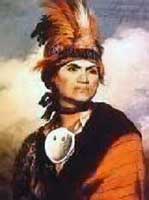 |
Brother Hawkins records that during the War of American Independence Brant was in command of some Indian troops on the British side, by whom Captain McKinsty, of the United States Army, had been captured. The Indians had tied their prisoner to a tree and were preparing to torture him, when he made the mystic appeal of a Freemason in the hour of danger. Brant interposed and rescued his American brother from his impending fate, took him to Quebec, and placed him in the hands of some English Freemasons, who returned him, uninjured, to the American outposts. Clavel has illustrated the occurrence on page 283 of his Histoire Pittoresque de la Franc-Maçonnerie. Joseph Brant, or Thayendanegea, to use his native name, was born on the banks of the Ohio River in 1742 and was educated at Lebanon, Connecticut. |
He was a member of Lodge No. 11 at the Mohawk village, about a mile and a half from Brantford, and was also affiliated with Barton Lodge No. 10 at Hamilton, Canada. Brother Robertson, History of Freemasonry in Canada, records (on page 687) that Brother Brant translated the Gospel of St. Mark into the Mohawk language and this was published in 1787.
Brother A. F. A. Woodford, Kenning's Cyclopoedia, says that he has been reported as Grand Master in England in 1502 and was probably connected with the Operative Lodges.
See Laver
See Pillars of the Porch
See Serpent and Cross
See Knight of the Brazen Serpent
The largest state and republic in South America. The first Lodge in Brazil is said to have been established by French authority as early as 1815. At any rate it was at work in 1820 and was divided into three parts which in 1821 met and formed the Grand Orient of Brazil according to the French Rite. In October, however, it was closed by order of the Emperor of Brazil, then Grand Master, and lay dormant for ten years.
Eight years later a Grand Orient of Brazil was formed with José Bonefacio de Andrada e Silva as Grand Master. In November, 1832, the Supreme Council of Belgium instituted a Supreme Council, Thirty-third Degree, which in 1832 was divided into three parts, each of which deemed to be a Supreme Grand Council. In 1835 there existed two Grand Orients and four Supreme Councils.
Out of these several Bodies there finally emerged the original Grand Orient which in 1863 divided into two, the Grand Orient of Lavrado Valley and the Grand Orient of Benedictino Valley, the former inclined to Roman Catholicism, the latter opposed to it.
In 1872 the two parties united; the following year they divided again. An attack by the Bishop of Pemambuco was the indirect cause of a movement towards Masonic union in 1877, and on January 18, 1883, the union was achieved in a Body which recognized the Ancient and Accepted Scottish Rite, the Modem French Rite and the Adonhiramite Rite.
In 1914 the Grand Orient exercised authority over 390 constituent Lodges, while England, Germany, and Italy were also represented in this territory. A further 50 Lodges paid allegiance to the Grand Orients of Parana and Rio Grande do Sul, the former of which has since united with the Grand Orient at Rio de Janeiro.
There are two German Lodges at Porto Alegre, and one each at Sertas S. Anna, Sapyranga, Santa Cruz, Candelaria, and Joinville. The Grand Orient of Italy has a Lodge at Botucatu, and one at San Paolo.
Eugene Seeger, formerly Consul-General of the United States at Rio de Janeiro, in an article on Brazil (see Current History, July, 1923), referred to the popularity of Freemasonry there and asserted that it was largely due to the great number of free public schools established and supported by the Freemasons for educating future citizens of that republic.
Consecrated bread and wine, that is to say, bread and wine used not simply for food, but made sacred by the purpose of symbolizing a bond of brotherhood, and the eating and drinking of which are sometimes called the Communion of the Brethren, is found in some of the advanced Degrees, such as the Order of High Priesthood in the American Rite, and the Rose Croix of the French and Scottish Rites.
It was in ancient times a custom religiously observed, that those who sacrificed to the gods should unite in partaking of a part of the food that had been offered. And in the Jewish Church it was strictly commanded that the sacrificers should "eat before the Lord", and unite in a feast of joy on the occasion of their offerings. By this common partaking of that which had been consecrated to a sacred purpose, those who partook of the feast seemed to give an evidence and attestation of the sincerity with which they made the offering; while the feast itself was, as it were, the renewal of the covenant of friendship between the parties.
See Form of the Lodge
In one of the Old Lectures, quoted by Doctor Oliver, it is said:
"A Mason's breast should be a safe and sacred repository for all your just and lawful secrets. A brother's secrets, delivered to me as such, I would keep as my own; as to betray that trust might be doing him the greatest injury he could sustain in this mortal life; nay, it would be like the villainy of an assassin who lurks in darkness to stab his adversary when unarmed and least prepared to meet an enemy".
It is true, that the secrets of a Freemason, confided as such, should be as inviolate in the breast of him who has received them as they were in his own before they were confided. But it would be wrong to conclude that in this a Freemason is placed in a position different from that which is occupied by every honorable man. No man of honor is permitted to reveal a secret which he has received under the pledge of secrecy.
Nevertheless, it is as false as it is absurd, to assert that either the man of honor or the Freemason is bound by any such obligation to protect the criminal from the vindication of the law. It must be left to every man to determine by his own conscience whether he is at liberty to betray a knowledge of facts with which he could not have become acquainted except under some such pledge. No court of law would attempt to extort a communication of facts made known by a penitent to his confessor or a client to his lawyer for such a communication would make the person communicating it infamous. In this case, Freemasonry supplies no other rule than that which is found in the acknowledged codes of Moral Ethics.
Called in Hebrew kho'shen, or kho-shen mish-pow, the breastplate of judgment, because through it the High Priest received divine responses, and uttered his decisions on all matters relating to the good of the commonwealth. It was a piece of embroidered cloth of gold, purple, scarlet, and fine white, twined linen. It was a span, or about nine inches square, when doubled, and made thus strong to hold the precious stones that were set in it. It had a gold ring at each corner, to the uppermost of which were attached golden chains, by which it was fastened to the shoulder pieces of the ephod-the vestment worn by the High Priest over his tunic; while from the two lowermost went two ribbons of blue, by which it was attached to the girdle of the ephod, and thus held secure in its place.
In the breastplate were set twelve precious jewels, on each of which was engraved the name of one of the twelve tribes. The stones were arranged in four rows, three stones in each row. As to the order of arrangement and the names of the stones, there has been some difference among the authorities. The authorized version of the Bible gives them in this order:
|
|
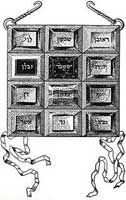 |
This is the pattern generally followed in the construction of Masonic breastplates, but modem researches into the true meaning of the Hebrew names of the stones have shown its inaccuracy.
Especially must the diamond be rejected, as no engraver could have cut a name on this impenetrable gem, to say nothing of the pecuniary value of a diamond of a size to match the rest of the stones.
| Josephus, Antiquities of the Jews (III, vii), gives the stones in the following order: | Kalisch, in his Colmmentary on Exodus, gives a still different order: | |||||||
| 1. | sardonyx | 7. | ligure | 1. | Cornelian (or sardius) | 7. | ligure | |
| 2. | topaz | 8. | amethyst | 2. | topaz | 8. | agate | |
| 3. | emerald | 9. | agate | 3. | smaragdus | 9. | amethyst | |
| 4. | carbuncle | 10. | chrysolite | 4. | carbuncle | 10. | chrysolite | |
| 5. | jasper | 11. | onyx | 5. | sapphire | 11. | onyx | |
| 6. | sapphire | 12. | beryl | 6. | emerald | 12. | jasper | |
But perhaps the Vulgate translation is to be preferred as an authority, because it was made in the fifth century, at a time when the old Hebrew names of the precious stones were better understood than now. The order given in that version is shown in the following diagram.
| EMERALD | TOPAZ | SARDIUS |
|---|---|---|
| JASPER | SAPPHIRE | CARBUNCLE |
| AMETHYST | AGATE | LIGURE |
| BERYL | ONYX | CHRYSOLITE |
A description of each of these stones, with its symbolic signification, with be found under the appropriate head.
On the stones were engraved the names of the twelve tribes, one on each stone. The order in which they were placed, according to the Jewish Targums - various ancient forms of the Hebrew Scriptures in Aramaic or Chaldee language, having a reference to the respective ages of the twelve sons of Jacob.
| LEVI | SIMEON | REUBEN |
| ZEBULUN | ISSACHAR | JUDAH |
| GAD | NAPHTALI | DAN |
| BENJAMIN | JOSEPH | ASHER |
The differences made by various writers in the order of the names of the stones arise only from their respective translations of the Hebrew words. These original names are detailed in Exodus (xxviii), and admit of no doubt, whatever uncertainty there may be as to the gems which they were intended to represent. The diagram below illustrates the Hebrew names of the stones.
|
|
|
|
|
|
|
|
|
|
|
|
"And thou shalt set in it settings of stones, even four rows of stones; the first row shall be a sardius, a topaz, and a carbuncle: this shall be the first row.
And the second row shall be an emerald, a sapphire, and a diamond.
And the third row a ligure, an agate, and an amethyst. And the fourth row a beryl, and an onyx, and a jasper:
they shall be set in gold in their enclosings. And the stones shall be with the names of the children of Israel, twelve according to their names, like the engravings of a signet; every one with his name shall they be according to the twelve tribes".
In the margin the word ruby is given instead of sardius in the first row of stones. The revised version suggests that ruby be substituted for sardius, emerald for carbuncle, carbuncle for emerald, sardonyx for diamond, amber for ligure or jacinth, chalcedony for beryl, and beryl for onyx, in the list found in Exodus xxviii.
Students of the Scriptures conclude that from the dimensions of the breastplate, given in Exodus (chapter xxviii ), a span which would be equivalent to eight or nine inches, the twelve stones even after allowing some reasonable space for their setting must have been of considerable size and therefore of only moderate rarity. Furthermore, as they were engraved with the names of the twelve tribes they could have been of only moderate hardness; and finally, preference may well be given to stones which research has shown to have been actually used for ornamental purposes in early bible times. In regard to this matter the article by Professor Flinders Petrie is of especial importance (see Hasting's Dictionary of the Bible, iv, pages 619-21).
The breastplate which was used in the first Temple does not appear to have been returned after the Captivity, for it is not mentioned in the list of articles sent back by Cyrus. The stones, on account of their great beauty and value, were most probably removed from their original arrangement and reset in various ornaments by their captors. A new one was made for the services of the second Temple, which, according to Josephus, when worn by the High Priest, shot forth brilliant rays of fire that manifested the immediate presence of Jehovah. But Josephus adds that two hundred years before his time this miraculous power had become extinct in consequence of the impiety of the nation. It was subsequently carried to Rome together with the other spoils of the Temple.
The breastplate is worn in American Chapters of the Royal Arch by the High Priest as an essential Part of his official vestments. The symbolic reference of it, as given by Webb, is that it is to teach him always to bear in mind his responsibility to the laws and ordinances of the Institution, and that the honor and interests of his Chapter should be always near his heart.
This does not materially differ from the ancient symbolism, for one of the names given to the Jewish breastplate was the memorial, because it was designed to remind the High Priest how dear the tribes whose names it bore should be to his heart.
The breastplate does not appear to have been original with or peculiar to the Jewish ritual. The idea was, most probably, derived from the Egyptians.
Diodorus Siculus says (in his book 1, chapter 75), that among them the chief judge bore about his neck a chain of gold, from which hung a figure or image , composed of precious stones, which was called Truth, and the legal proceedings only commenced when the chief judge had assumed this image.
Aelian (book xxxiv), confirms this account by saying that the image was engraved on sapphire, and hung about the neck of the chief judge with a golden chain.
Peter du Val says that he saw a mummy at Cairo, round the neck of which was a chain, to which a golden plate was suspended, on which the image of a bird was engraved (see Urim and Thummim).
One of the three precious jewels of a Fellow Craft. It symbolically teaches the initiate that the lessons which he has received from the instructive tongue of the Master are not to be listened to and lost, but carefully treasured in his heart, and that the precepts of the Order constitute a covenant which he is faithfully to observe.
See Points of Fellowship
[- Previos: BELE - BLUE or BIBLE -] [- TOP -] [- Next: BRET - BY -]